Part 5: High Moon
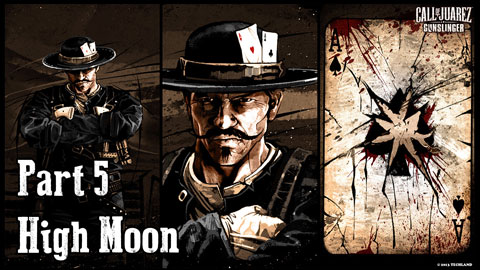
Some of the nuggets below are about people who are too (in)famous to properly cover in a few cards of text and further reading is definitely worth it. The Wikipedia article for John Wesley Hardin for example can barely move a sentence without Hardin killing multiple people.
Concept Art
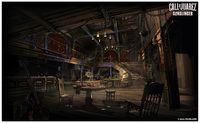
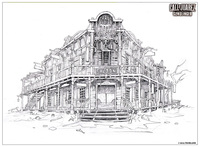
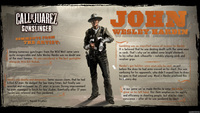
Nuggets of Truth
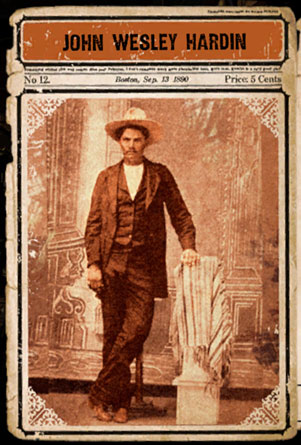
Hardin, born on May 26, 1853, was one of the West's most notorious killers. Next to Wild Bill Hickok, many considered him to be the fastest and most accurate gunslinger who ever lived, or at least the deadliest, as he is believed to have killed 41 men in various duels, shootouts, and other sundry incidents. One story has him shooting a man for snoring too loudly, but many believe that is simply a fanciful legend.
Some considered him a cold-blooded killer, while others thought of him as a folk hero. He had a price on his head from the age of fifteen, but Hardin allegedly only killed in self-defense or to defend his freedom. Finally arrested by the Texas Rangers, Hardin spent many years in prison, where he frequented the prison library and taught himself the law. He was sentenced to 25 years, but released after only 17 and promptly passed the bar exam. He tried to make a living as a lawyer, but proved to be a much better gambler. Hardin could usually be found sitting in a saloon, playing dice or cards.
It is an irony that one of the most deadly gunfighters who ever lived met his end the same way his idol, Wild Bill Hickok, did. Both were shot in the back of the head while gambling. Hickok was murdered by Jack McCall and Hardin by John Selman on August 19, 1895
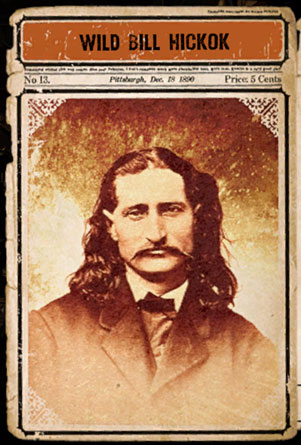
James Butler Hickok, also known as Wild Bill, is considered by some to be the most famous western gunslinger of all time. He is remembered as a tall, slender man with long flowing hair and an omnipresent pair of holstered Colt 1851 Navy cap and ball revolvers.
Born in Troy Grove, Illinois, in 1837, he worked as a stagecoach driver, fought for the Union army during the war and later became a scout, a lawman, an unlucky professional gambler, and a not very good actor, who trod the boards with Buffalo Bill until he realized that the theatre wasn't his true calling.
What he did best was put outlaws, killers, ornery assholes, and drunk cowboys in their graves by filling them full of lead. The high noon showdown in the middle of the street, a staple of Hollywood
Westerns, was not a very common occurrence. As a matter of fact, they hardly ever happened...unless Wild Bill happened to be in town. If anyone was willing to stand in the street at high noon and face someone down that would be William Butler Hickok.
In 1876, Hickok was diagnosed by a doctor in Kansas City with trachoma, an inflammation of the eye. He was losing his ability to see and so his marksmanship and health were on the wane. As his finances were in trouble, he set out for Deadwood, South Dakota where a recent gold strike had created a boomtown full of drunken miners; a perfect place for a professional gambler to ply his trade. On August 2nd of that year, while playing poker in the "Nutall & Mann's No. 10" saloon, Bill broke a rule he'd been following for years, perhaps for the first time ever. He sat with his back to the door. A former buffalo hunter named Jack McCall entered the saloon at that very moment and drew his revolver shouting, "Damn you! Take that!" and shot Bill on the spot. The bullet went right through the gunslinger's head and hit another player at the table in the wrist. Legend has it that at the moment of his death Wild Bill was holding a pair of aces and a pair of eights, all of them black. Since then that hand is commonly referred to as the dead man's hand.

When Phil Coe opened the Bull's Head in Abilene, Kansas, he enraged the local townsfolk by painting a picture of a bull on the side of his saloon. This particular bull had a large erect penis. The law in Abilene at the time was none other than 'Wild' Bill Hickok. He threatened to torch the building if the obscene painting was not removed promptly. Before Coe could make up his mind, Hickok paid a few men to paint over the bull and its offending private part. This infuriated Coe and he confronted Wild Bill. Coe clearly disliked Hickok and this animosity grew until one day Coe fired two shots at the marshal and missed. Hickok returned fire, cutting Coe down. He also accidentally killed his own deputy, Mike Williams, who was coming to his aid. Williams' death haunted Hickok until the very end of his life.

Before barbed wire was used to divide the free ranges of the Wild West, cattle rustling had thrived. Many famous outlaws of the time like Billy the Kid, the Clantons, Curly Bill, and Johnny Ringo all tried their hand at stealing cattle. It was obviously considered a serious offense and punished accordingly. More often than not, a cattle thief never had a chance to appear in court because a vigilante group would usually lynch the criminal on the spot. Those unlucky desperados hung as grim decorations, dangling solemnly from the branches of roadside trees. It's not surprising considering the fact that cattle were the primary commodity of the West. It was often easier to get away with murder than with stealing a cow.
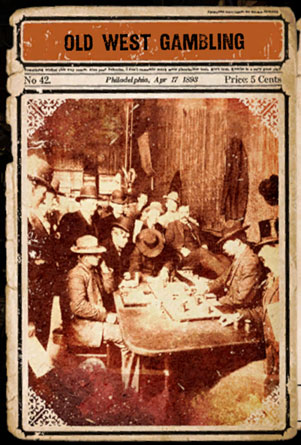
The Old West was populated with all sorts of adventurers, fortune seekers, thieves, gamblers, and gold diggers. Where there was gold or - in the absence of the noblest element – at least a dollar or two, there were opportunities to spend it. Neither corn whiskey nor saloon girls were free. Saloon owners, however, did offer a third form of entertainment. One that, in theory at least, offered the customer a chance to actually make money, gambling.
Poker, dice, and faro, beloved by all, reigned supreme. Where gambling appeared, accusations of cheating usually followed. Let's face it; it was probably a common occurrence. The trick was to do it without getting caught. Plan B was to be so intimidating, no one would dare call you on your seemingly miraculous hand. Naturally, confidence alone wasn't enough. Lightning reflexes and the ability to shoot straight was necessary as well. That's why many famous gamblers were also skilled gunslingers. Celebrities of the West like Doc Holliday, Wes Hardin, and Wild Bill Hickok all fit that description to a T.
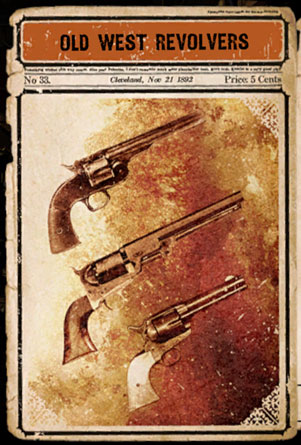
Next to the cowboy hat, the object most often associated with the Wild West is the percussion cap revolver, invented by Samuel Colt in 1836. This revolver, along with the Winchester repeating rifle, was the preferred method for dealing death in the latter part of the nineteenth century.
The first revolvers were front loading models. Black gunpowder was inserted into the chambers of the cylinder and then covered with a lead bullet. Rammers were used to keep everything in place. All that was left was to place percussion caps on the opposite end of the cylinder. Because of that, the early revolvers were known as caplocks, with the cap and the ball inserted separately. The Colt Patterson and its later incarnations were examples of that design philosophy. This includes the Walker, the Dragoon, the 1851 Navy (Wild Bill Hickok used a pair), the Model 1860 Army and others. The Remington Model 1858 was a unique design because it allowed for the replacement of empty cylinders for loaded ones in the midst of a fight.
Later models used integrated cartridges as ammunition, eliminating the need to load each component separately. The Smith & Wesson Model 3 was such a design (one of its variants is known as the Schofield Revolver) and so were Colt's more advanced products. Revolvers also evolved from single-action (where the cylinder had to be rotated by manually cocking the gun) into so-called double-action, where the trigger mechanism would also cock the gun and turn the cylinder with a single motion. One thing remained unchanged throughout the history of the Wild West, in the hands of a skilled gunman, revolvers were deadly weapons.